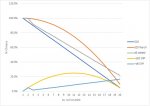Well, prior to Ovinomancer's post, I was going to say the two were probably about even,other than the potential for +d6 giving a chance for results above 20.
My gut still says something's a bit off with that graph, but I haven't gone through the math, myself. Basically, advantage is roughly equal to a +5 bonus at a DC 11, tapering to an effective +1 (or marginally less) at either end. The d6 should be a consistent +3.5 across the entire spectrum. I guess the net effect is that, at the low end, advantage has the potential to completely offset a horrible roll, whereas +d6 doesn't -- regardless of "equivalent" bonuses. So, that's probably where the actual math disproves my gut.
I guess that means the decision between the two (disadvantage and hero points) comes down to whether you'd rather insulate the PCs from the occasional cursed die (advantage) or give them the opportunity to play outside their weight class if the dice smile (hero points).
Personally, I think the hero points sounds a bit more fun, myself. I wouldn't object to either style and would be fully aware that it might not play out as fun as it sounds.
-up]

